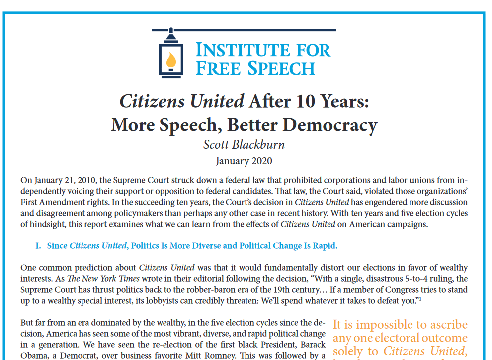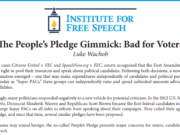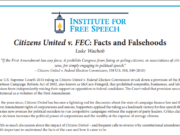PDF of analysis available here
On January 21, 2010, the Supreme Court struck down a federal law that prohibited corporations and labor unions from independently voicing their support or opposition to federal candidates. That law, the Court said, violated those organizations’ First Amendment rights. In the succeeding ten years, the Court’s decision in Citizens United has engendered more discussion and disagreement among policymakers than perhaps any other case in recent history. With ten years and five election cycles of hindsight, this report examines what we can learn from the effects of Citizens United on American campaigns.
I. Since Citizens United, Politics Is More Diverse and Political Change Is Rapid.
One common prediction about Citizens United was that it would fundamentally distort our elections in favor of wealthy interests. As The New York Times wrote in their editorial following the decision, “With a single, disastrous 5-to-4 ruling, the Supreme Court has thrust politics back to the robber-baron era of the 19th century… If a member of Congress tries to stand up to a wealthy special interest, its lobbyists can credibly threaten: We’ll spend whatever it takes to defeat you.”[1]
But far from an era dominated by the wealthy, in the five election cycles since the decision, America has seen some of the most vibrant, diverse, and rapid political change in a generation. We have seen the re-election of the first black President, Barack Obama, a Democrat, over business favorite Mitt Romney. This was followed by a celebrity outsider Republican in Donald Trump beating consummate Washington insider Hillary Clinton. The House of Representatives has seen similar rapid change with both Republicans and Democrats taking the House in populist waves. This is perhaps best exemplified by major establishment power brokers Eric Cantor and Joe Crowley being bested by political neophytes and outsiders David Brat and Alexandria Ocasio-Cortez, respectively.
It is impossible to ascribe any one electoral outcome solely to Citizens United, but the prevalence of new voices in the political arena since the decision is undeniable. At the very least, it seems highly unlikely that if powerful moneyed interests were putting their finger on the scale of elections to a greater degree post-Citizens United, these are the outcomes they would have sought.
II. Incumbents and Challengers Have Both Benefited From Super PAC Support – but the Support Helps Challengers More.
Supporters of Citizens United, far from believing the decision hindered democratic ideals, regarded it as a boon to democracy by allowing political outsiders to more easily challenge incumbents and the status quo. As famed First Amendment attorney 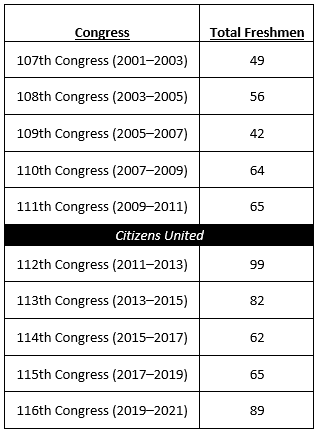 Floyd Abrams put it, “We want, for example, more Gene McCarthys and Ross Perots and individuals to come upon the scene and have a chance to build a war chest and go on out and try to reform the country as they think best.”[2] The elections since the decision have certainly seen a significant amount of new blood in Washington, many of whom benefited from super PAC spending that was not tied to the traditional levers of party power. But incumbent politicians and insiders also quickly learned to take advantage of this new tool of campaigning.
Floyd Abrams put it, “We want, for example, more Gene McCarthys and Ross Perots and individuals to come upon the scene and have a chance to build a war chest and go on out and try to reform the country as they think best.”[2] The elections since the decision have certainly seen a significant amount of new blood in Washington, many of whom benefited from super PAC spending that was not tied to the traditional levers of party power. But incumbent politicians and insiders also quickly learned to take advantage of this new tool of campaigning.
The best example of this is perhaps Right to Rise, the super PAC set up by supporters of Jeb Bush heading into the 2016 Republican primary. That group spent over $120 million peppering primary states with pro-Bush ads. But while Right to Rise bought a lot of ads, it failed to convince many voters. Super PACs supporting newcomers have had better success, as groups like Independent USA PAC[3] and Women Vote![4] were able to give key support to previously unknown candidates.
All told, the five election cycles since Citizens United saw an average of 79 freshmen members of Congress. The five cycles prior to the decision saw just 55.[5]
III. For-Profit Corporations Are Not Big Spenders in Campaigns.
In the immediate wake of Citizens United, the main prediction from those opposed to the decision concerned corporate spending in elections. As one commentator put it, “today’s decision does far more than simply provide Fortune 500 companies with a massive megaphone to blast their political views to the masses; it also empowers them to drown out any voices that disagree with them.”[6] Simply put, this has not happened.
Corporate political spending continues to be dwarfed by spending from other traditional sources. In the four cycles since the decision,[7] for-profit corporate political spending has averaged around 1% of spending from all sources. The following chart below shows total campaign contributions[8] to any entity – candidates, political parties, standard PACs, super PACs, and other groups) (in blue), total contributions to independent groups from any source (including individuals, PACs, corporations, and unions) (in orange), and for-profit corporate contributions to independent groups (predominantly super PACs) (in red).[9]
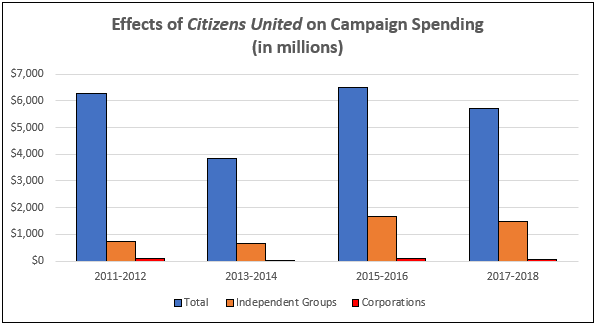
No matter how you slice it, Citizens United has not led to a flood of corporate money in our elections.
IV. Money Still Can’t “Buy” an Election.
Despite a near constant drumbeat from some politicians and activist groups, in the post-Citizens United era, money cannot and does not buy elections. In fact, this is conventional wisdom among most experts. As University of Missouri professor Jeff Milyo wrote:
[T]here is something of a scholarly consensus . . . stand[ing] in stark contrast to the popular wisdom so often echoed by pundits, politicians and reform advocates that elections are essentially for sale to the highest bidder (spender). Decades of social science research consistently reveal a far more limited role for campaign spending.[12]
Since 2010, this truism has been demonstrated again and again, from the spectacular failure of deep-pocketed Jeb Bush[13] to the meteoric rise of the heavily outspent Alexandria Ocasio-Cortez.[14] It is true, both before and after Citizens United, that the candidate who spends more money usually wins, but while spending certainly helps campaigns, it does not cause the victory. Rather, candidates who attract more voters typically also attract more donors. The inability of spending to “buy” votes on Election Day is easiest to see in the almost cliché trend of rich individuals self-funding lavish campaigns and underperforming when actual votes are counted, sometimes spectacularly so.[15] As Richard Lau, Professor of Political Science at Rutgers, put it, “I think where you have to change your thinking is that money causes winning. I think it’s more that winning attracts money.”[16]
V. Most Campaign Spending Still Comes From Limited Contributions by Individuals to Candidates.
The emergence of super PACs[17] – political groups that exclusively make independent expenditures and therefore can accept contributions of any size – has been the largest and most significant innovation of the Citizens United decision. (Though technically it was a different case – SpeechNow.org v. FEC – that permitted the creation of super PACs, that unanimous decision followed the reasoning of Citizens United.[18]) And it is true that super PAC spending has been increasing, as more and more groups see the advantages of independent speech.
Nevertheless, the overall impact of super PACs has been overstated. At the time of the decision, it was argued that, “[those] players with the deepest pockets will be able to pay premium prices for as many ads as they want, easily dominating the airwaves.”[19] But significantly more political spending is funded by donors that must abide by strict contribution limits, namely those who give to candidates and political parties. Contributions to super PACs have ranged from 12% to 26% of total political contributions over the four cycles since Citizens United. Candidates and political parties continue to outspend super PACs by at least three-to-one.
It’s also worth remembering that federal law automatically gives candidates the lowest cost for a political ad on TV or radio,[20] meaning a dollar of super PAC spending buys less speech than the same dollar of candidate spending.
VI. The Government Cannot Ban Political Books or Movies.
Most forgotten in the decade since Citizens United is the actual speech the Court protected. The case was about political speech in its purest form and the government’s belief that it could regulate and prohibit that speech. Citizens United is a nonprofit corporation that, in 2008, wanted to advertise and sell on-demand a documentary critical of then-Democratic primary candidate Hillary Clinton. The Federal Election Commission said doing so would be illegal, because it was funded by a corporation, and any corporate spending that supports, opposes, or even mentions a candidate close to an election is prohibited (unless the speaker is a media corporation). In defending that position, the government went further, arguing to the Supreme Court that it could prohibit companies from publishing books that contained a single line advocating for or against a candidate.
Those were the facts before the Supreme Court Justices when they issued their ruling. A rule that bans this speech must be inconsistent with the First Amendment. As Justice Anthony Kennedy put it in the majority’s opinion: “political speech must prevail against laws that would suppress it.”[21]
Thanks to the Citizens United ruling, companies like Netflix and Amazon don’t have to worry about streaming political documentaries during election season, small publishing houses don’t have to hire a campaign finance attorney before publishing political books, and the government is one step further removed from policing political speech.
VII. There is More Speech About Candidates Now Than Ever Before.
By legalizing corporate and union independent expenditures and paving the way for super PACs, Citizens United opened up new and useful avenues for speech. Americans are speaking more now than ever before.
This is true in monetary terms – campaign spending is up, as candidates and independent groups attempt to persuade voters through the airwaves and over the internet. It is also true in human terms. The Supreme Court’s ruling has allowed Americans to innovate new ways of organizing and speaking to promote their shared ideas. Challengers and newcomers, in particular, have found unexpected and sometimes highly persuasive ways to speak, providing them the opportunity to catch-up and compete both with incumbent politicians and established political powerbrokers. And research shows that all of this speech, from mailers to TV ads, make voters more informed and more engaged.[22]
While Citizens United hasn’t resulted in a flood of corporate cash “drowning out” ordinary voices, it has allowed new, often very important, voices to be heard. The decision not only protects the right to speak, but it protects the right of Americans to hear those voices. Citizens, rather than the government, decide what arguments are worthwhile. Citizens United is one of the most important decisions of the century for protecting, fostering, and benefiting American democracy.
[1] Editorial, “The Court’s Blow to Democracy,” The New York Times. Retrieved on January 14, 2020. Available at: https://www.nytimes.com/2010/01/22/opinion/22fri1.html (January 21, 2010).
[2] James Taranto, “The Media and Corporate Free Speech,” The Wall Street Journal. Retrieved on January 13, 2020. Available at: http://www.jamestaranto.com/abrams.htm (January 30, 2010).
[3] See “Independence USA PAC,” Center for Responsive Politics. Retrieved on January 13, 2020. Available at: https://www.opensecrets.org/pacs/indexpend.php?strID=C00532705&cycle=2018 (June 20, 2019).
[4] See “Women Vote!,” Center for Responsive Politics. Retrieved on January 13, 2020. Available at: https://www.opensecrets.org/pacs/indexpend.php?strID=C00473918&cycle=2018 (June 20, 2019).
[5] “First-Term Members of the House of Representatives,” U.S. House of Representatives. Retrieved on January 13, 2020. Available at: https://history.house.gov/Institution/First-Term/First-Term-Numbers/. For data on the 116th Congress, see “Membership of the 116th Congress: A Profile,” Congressional Research Service. Retrieved on January 13, 2020. Available at: https://fas.org/sgp/crs/misc/R45583.pdf (January 14, 2020).
[6] Ian Millhiser, “Citizens United Decision: ‘A Rejection Of The Common Sense Of The American People’,” ThinkProgress. Retrieved on January 13, 2020. Available at: https://thinkprogress.org/citizens-united-decision-a-rejection-of-the-common-sense-of-the-american-people-d7b83c583b1b/ (January 21, 2010).
[7] This excludes the 2010 election cycle, which occurred both before and after Citizens United. Comparable data on corporate contributions for that cycle was not readily available.
[8] “Cost of Election,” Center for Responsive Politics. Retrieved on January 13, 2020. Available at: https://www.opensecrets.org/overview/cost.php?display=T&infl=N.
[9] Karl Evers-Hillstrom, “In hyperpartisan political environment, major corporations stay away from controversial super PACs,” Center for Responsive Politics. Retrieved on January 13, 2020. Available at: https://www.opensecrets.org/news/2019/04/major-corporations-stay-away-from-controversial-pacs20/ (April 12, 2019).
[10] Bill Allison and Sarah Harkins, “Fixed Fortunes: Biggest corporate political interests spend billions, get trillions,” Sunlight Foundation. Retrieved on January 13, 2020. Available at: https://sunlightfoundation.com/2014/11/17/fixed-fortunes-biggest-corporate-political-interests-spend-billions-get-trillions/ (November 17, 2014).
[11] Anu Narayanswamy, Chris Alcantara, and Michelle Ye Hee Lee, “Meet the wealthy donors pouring millions into the 2018 elections,” The Washington Post. Retrieved on January 14, 2020. Available at: https://www.washingtonpost.com/graphics/2018/politics/superpac-donors-2018/ (October 26, 2018).
[12] Jeff Milyo, “Campaign Spending and Electoral Competition: Towards More Policy Relevant Research,” The Forum: A Journal of Applied Research in Contemporary Politics. Vol. 11, No. 3 (October 2013), 437-454. Jeff Milyo is an Academic Advisor to the Institute for Free Speech. Milyo’s research was completed independently.
[13] Zachary Mider, The Failure of Money to Buy the Presidential Nomination, in One Chart,” Bloomberg. Retrieved on January 13, 2020. Available at: https://www.bloomberg.com/news/articles/2016-02-17/the-failure-of-money-to-buy-the-presidential-nomination-in-one-chart (February 17, 2016).
[14] Conor Lynch, “Alexandria Ocasio-Cortez proves that money doesn’t win elections: Are Democrats listening?,” Salon. Retrieved on January 13, 2020. Available at: https://www.salon.com/2018/07/06/alexandria-ocasio-cortez-proves-that-money-doesnt-win-elections-are-democrats-listening/ (July 6, 2018).
[15] See Joe Albanese, “Failure of Campaign Self-Funders Highlights Once Again that Money Doesn’t Buy Elections,” Institute for Free Speech. Retrieved on January 13, 2020. Available at: https://www.ifs.org/blog/failure-of-campaign-self-funders-highlights-once-again-that-money-doesnt-buy-elections/ (March 20, 2017).
[16] Maggie Koerth, “How Money Affects Elections,” FiveThirtyEight. Retrieved on January 13, 2020. Available at: https://fivethirtyeight.com/features/money-and-elections-a-complicated-love-story/ (September 10, 2018).
[17] See Luke Wachob, “Super PACs: Expanding Freedom of Speech,” Institute for Free Speech. Retrieved on January 13, 2020. Available at: https://www.ifs.org/wp-content/uploads/2017/10/2017-10-30_Issue-Brief_Wachob_Super-PACs-Expanding-Freedom-Of-Speech.pdf (October 30, 2017).
[18] See Luke Wachob, “SpeechNow.org v. Federal Election Commission: Protecting the First Amendment Rights of Americans,” Institute for Free Speech. Retrieved on January 13, 2020. Available at: https://www.ifs.org/wp-content/uploads/2018/03/2018-03-26_Issue-Brief_Wachob_SpeechNow.org-v-FEC-Protecting-The-First-Amendment-Rights-of-Americans.pdf (March 26, 2018).
[19] Ron Gettelfinger and Larry Cohen, “Why the Citizens United decision undermines democracy,” The Hill. Retrieved on January 13, 2020. Available at: https://thehill.com/opinion/op-ed/79373-why-the-citizens-united-decision-undermines-democracy (February 2, 2010).
[20] David Oxenford, “Political Broadcasting Reminder Part 1 – The Basics of Lowest Unit Charges,” Broadcast Law Blog. Retrieved on January 13, 2020. Available at: https://www.broadcastlawblog.com/2012/09/articles/political-broadcasting-reminder-part-1-the-basics-of-lowest-unit-charges/ (September 10, 2012).
[21] Citizens United v. Fed. Election Comm’n, 558 U.S. 310 (2010).
[22] See Paul Freedman, Michael Franz, and Kenneth Goldstein, “Campaign Advertising and Democratic Citizenship,” American Journal of Political Science. Vol. 48, No. 4 (October 2004), 723–741.










